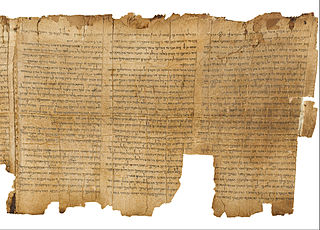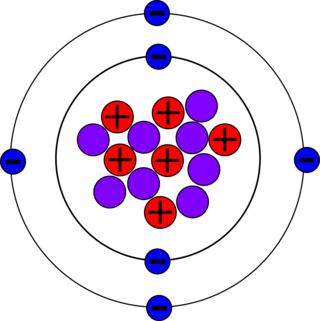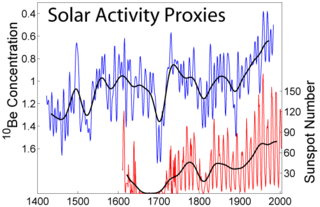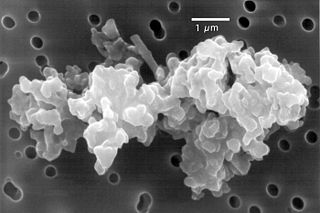Related Research Articles

Radiocarbon dating is a method for determining the age of an object containing organic material by using the properties of radiocarbon, a radioactive isotope of carbon.

Carbon-14, C-14, 14
C or radiocarbon, is a radioactive isotope of carbon with an atomic nucleus containing 6 protons and 8 neutrons. Its presence in organic materials is the basis of the radiocarbon dating method pioneered by Willard Libby and colleagues (1949) to date archaeological, geological and hydrogeological samples. Carbon-14 was discovered on February 27, 1940, by Martin Kamen and Sam Ruben at the University of California Radiation Laboratory in Berkeley, California. Its existence had been suggested by Franz Kurie in 1934.

The solar cycle, also known as the solar magnetic activity cycle, sunspot cycle, or Schwabe cycle, is a nearly periodic 11-year change in the Sun's activity measured in terms of variations in the number of observed sunspots on the Sun's surface. Over the period of a solar cycle, levels of solar radiation and ejection of solar material, the number and size of sunspots, solar flares, and coronal loops all exhibit a synchronized fluctuation from a period of minimum activity to a period of a maximum activity back to a period of minimum activity.

Advanced Composition Explorer is a NASA Explorer program satellite and space exploration mission to study matter comprising energetic particles from the solar wind, the interplanetary medium, and other sources.
The Spörer Minimum is a hypothesized 90-year span of low solar activity, from about 1460 until 1550, which was identified and named by John A. Eddy in a landmark 1976 paper published in Science titled "The Maunder Minimum". It occurred before sunspots had been directly observed and was discovered instead by analysis of the proportion of carbon-14 in tree rings, which is strongly correlated with solar activity. It is named for the German astronomer Gustav Spörer.

Beryllium-10 (10Be) is a radioactive isotope of beryllium. It is formed in the Earth's atmosphere mainly by cosmic ray spallation of nitrogen and oxygen. Beryllium-10 has a half-life of 1.39 × 106 years, and decays by beta decay to stable boron-10 with a maximum energy of 556.2 keV. It decays through the reaction 10Be→10B + e−. Light elements in the atmosphere react with high energy galactic cosmic ray particles. The spallation of the reaction products is the source of 10Be (t, u particles like n or p):

Cosmic dust – also called extraterrestrial dust, space dust, or star dust – is dust that occurs in outer space or has fallen onto Earth. Most cosmic dust particles measure between a few molecules and 0.1 mm (100 μm), such as micrometeoroids. Larger particles are called meteoroids. Cosmic dust can be further distinguished by its astronomical location: intergalactic dust, interstellar dust, interplanetary dust, and circumplanetary dust. There are several methods to obtain space dust measurement.
Beryllium (4Be) has 11 known isotopes and 3 known isomers, but only one of these isotopes is stable and a primordial nuclide. As such, beryllium is considered a monoisotopic element. It is also a mononuclidic element, because its other isotopes have such short half-lives that none are primordial and their abundance is very low. Beryllium is unique as being the only monoisotopic element with both an even number of protons and an odd number of neutrons. There are 25 other monoisotopic elements but all have odd atomic numbers, and even numbers of neutrons.
The Kamioka Observatory, Institute for Cosmic Ray Research is a neutrino and gravitational waves laboratory located underground in the Mozumi mine of the Kamioka Mining and Smelting Co. near the Kamioka section of the city of Hida in Gifu Prefecture, Japan. A set of groundbreaking neutrino experiments have taken place at the observatory over the past two decades. All of the experiments have been very large and have contributed substantially to the advancement of particle physics, in particular to the study of neutrino astronomy and neutrino oscillation.
A neutron monitor is a ground-based detector designed to measure the number of high-energy charged particles striking the Earth's atmosphere from outer space. For historical reasons the incoming particles are called "cosmic rays", but in fact they are particles, predominantly protons and Helium nuclei. Most of the time, a neutron monitor records galactic cosmic rays and their variation with the 11-year sunspot cycle and 22-year magnetic cycle. Occasionally the Sun emits cosmic rays of sufficient energy and intensity to raise radiation levels on Earth's surface to the degree that they are readily detected by neutron monitors. They are termed "ground level enhancements" (GLE).
Superflares are very strong explosions observed on stars with energies up to ten thousand times that of typical solar flares. The stars in this class satisfy conditions which should make them solar analogues, and would be expected to be stable over very long time scales. The original nine candidates were detected by a variety of methods. No systematic study was possible until the launch of the Kepler space telescope, which monitored a very large number of solar-type stars with very high accuracy for an extended period. This showed that a small proportion of stars had violent outbursts, up to 10,000 times as powerful as the strongest flares known on the Sun. In many cases there were multiple events on the same star. Younger stars were more likely to flare than old ones, but strong events were seen on stars as old as the Sun.
CI chondrites, also called C1 chondrites or Ivuna-type carbonaceous chondrites, are a group of rare carbonaceous chondrite, a type of stony meteorite. They are named after the Ivuna meteorite, the type specimen. CI chondrites have been recovered in France, Canada, India, and Tanzania. Their overall chemical composition closely resembles the elemental composition of the Sun, more so than any other type of meteorite.

The 774–775 carbon-14 spike is an observed increase of around 1.2% in the concentration of the radioactive carbon-14 isotope in tree rings dated to 774 or 775 CE, which is about 20 times higher than the normal year-to-year variation of radiocarbon in the atmosphere. It was discovered during a study of Japanese cedar tree-rings, with the year of occurrence determined through dendrochronology. A surge in beryllium isotope 10
Be, detected in Antarctic ice cores, has also been associated with the 774–775 event. The 774–775 CE carbon-14 spike is one of several Miyake events and it produced the largest and most rapid rise in carbon-14 ever recorded.

In solar physics, a solar particle event (SPE), also known as a solar energetic particle (SEP) event or solar radiation storm, is a solar phenomenon which occurs when particles emitted by the Sun, mostly protons, become accelerated either in the Sun's atmosphere during a solar flare or in interplanetary space by a coronal mass ejection shock. Other nuclei such as helium and HZE ions may also be accelerated during the event. These particles can penetrate the Earth's magnetic field and cause partial ionization of the ionosphere. Energetic protons are a significant radiation hazard to spacecraft and astronauts.

Patterns of solar irradiance and solar variation have been a main driver of climate change over the millions to billions of years of the geologic time scale.

The 993–994 carbon-14 spike was a rapid 0.91% increase in carbon-14 isotope content from tree rings dated 993-994 CE. This event was also confirmed with an associated increase of beryllium-10 in Antarctic ice core samples, supporting the hypothesis that this event was of solar origin. There were several astronomical observations during this time that correspond with the 14C and 10Be spikes, but these texts are few and far between.
A Ground Level Enhancement or Ground Level Event (GLE), is a special subset of solar particle event where charged particles from the Sun have sufficient energy to generate effects which can be measured at the Earth's surface. These particles are accelerated to high energies either within the solar atmosphere or in interplanetary space, with some debate as to the predominant acceleration method. While solar particle events typically involve solar energetic particles at 10–100 MeV, GLEs involve particles with energies higher than about 400 MeV.
A Miyake event is an observed sharp enhancement of the production of cosmogenic isotopes by cosmic rays. It can be marked by a spike in the concentration of radioactive carbon isotope 14
C in tree rings, as well as 10
Be and 36
Cl in ice cores, which are all independently dated. At present, five significant events are known for which the spike in 14
C is quite remarkable, i.e. above 1% rise over a period of 2 years, and four more events need independent confirmation. It is not known how often Miyake events occur, but from the presently available data it is estimated that such an event would occur once every 400–2400 years.
References
- 1 2 "MIYAKE Fusa". Nagoya University. Retrieved 20 February 2024.
- 1 2 Miyake, F.; Nagaya, K.; Masuda, K.; Nakamura, T. (2012). "A signature of cosmic-ray increase in AD 774–775 from tree rings in Japan". Nature . 486: 240. doi:10.1038/nature11123.
- ↑ Usoskin, F.; Kromer, B.; Ludlow, F.; Beer, J.; Friedrich, M.; Kovaltsov, G.; Solanki, S.K.; Wacker, L. (2013). "The AD775 cosmic event revisited: the Sun is to blame". Astron. Astrophys. Lett. 552: L3. doi:10.1051/0004-6361/201321080.
- ↑ Usoskin, F.; Kovaltsov, G. (2012). "Occurrence of Extreme Solar Particle Events: Assessment from Historical Proxy Data". Astrophys. J. 757: 92. doi:10.1088/0004-637X/757/1/92.
- 1 2 3 Kornei, Katherine. "Mystery of ancient space superstorms deepens". Scientific American. Retrieved 20 February 2024.
- ↑ Miyake, Fusa; Masuda, Kimiaki; Nakamura, Toshio (2013). "Another rapid event in the carbon-14 content of tree rings". Nature Communications. 4: 1748. Bibcode:2013NatCo...4.1748M. doi: 10.1038/ncomms2783 . PMID 23612289. S2CID 256624509.
- ↑ Miyake, Fusa; Masuda, Kimiaki; Nakamura, Toshio (2013). "Another rapid event in the carbon-14 content of tree rings". Nature Communications. 4: 1748. doi:10.1038/ncomms2783 . Retrieved 20 February 2024.
- ↑ Carlson, Erika K. "Sun's Past Hidden in Tree Rings". American Physical Society. Retrieved 20 February 2024.
- ↑ "José A. Boninsegna Frontiers in Dendrochronology Award was given to Associate Professor Fusa Miyake". Nagoya University - Institute for Space-Earth Environmental Research. Retrieved 20 February 2024.